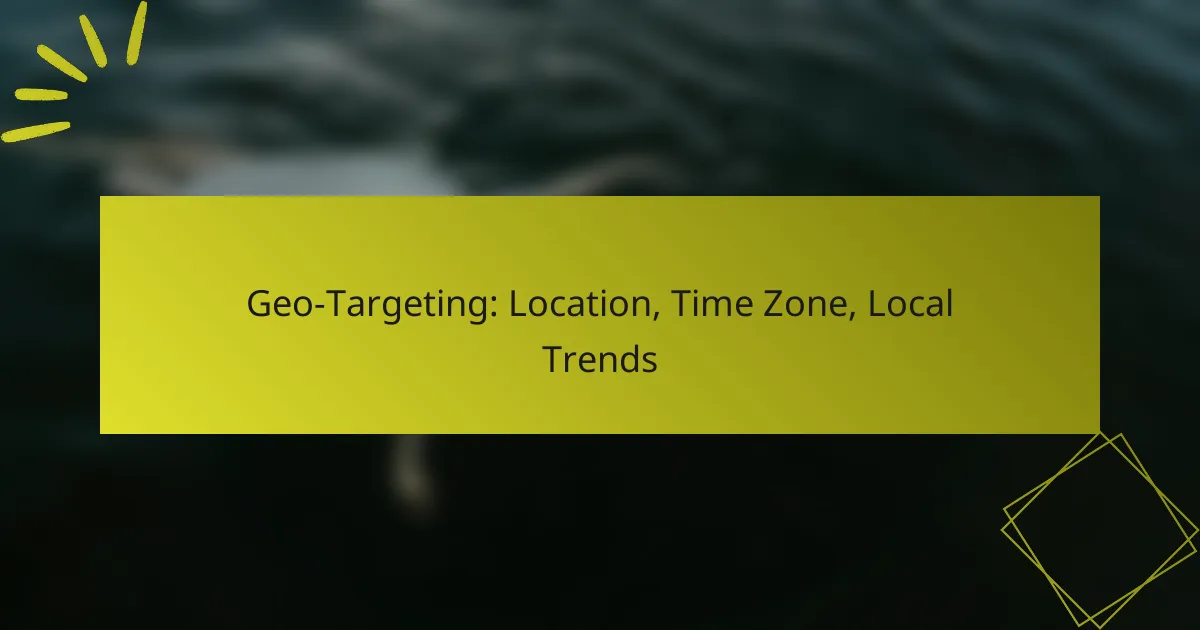Geo-targeting is a powerful strategy that allows businesses to deliver personalized advertisements based on specific locations, time zones, and local trends. By aligning marketing efforts with the unique characteristics of different geographic areas, companies can significantly enhance audience engagement and conversion rates. Understanding local consumer behavior and preferences is essential for crafting effective campaigns that resonate with target audiences.

How does geo-targeting improve display advertising?
Geo-targeting enhances display advertising by delivering ads tailored to specific locations, time zones, and local trends. This approach ensures that advertisements resonate more with the audience, leading to improved performance and effectiveness.
Increased ad relevance
Geo-targeting increases ad relevance by allowing advertisers to customize their messages based on the geographical location of the audience. For example, a restaurant in Paris can promote local dishes or special offers that appeal specifically to residents or tourists in that area. This localized approach helps capture the attention of potential customers who are more likely to engage with content that feels personally relevant.
By leveraging local language, cultural references, and regional preferences, businesses can create ads that resonate more deeply with their target audience. This tailored messaging can significantly enhance the effectiveness of advertising campaigns.
Higher engagement rates
With geo-targeting, businesses often see higher engagement rates as ads are served to users who are more likely to respond positively. When ads are relevant to a user’s location, they are more likely to click through or take action. For instance, a clothing retailer can target ads for winter apparel to users in colder regions during the winter months, increasing the likelihood of interaction.
Additionally, using local events or trends in advertising can further boost engagement. For example, promoting a local festival or holiday sale can attract attention and drive traffic to a business, resulting in more meaningful interactions with potential customers.
Improved ROI
Geo-targeting can lead to improved return on investment (ROI) for advertising campaigns by ensuring that marketing budgets are spent more efficiently. By focusing on specific locations where potential customers are most likely to convert, businesses can reduce wasted ad spend on audiences that are less relevant. This targeted approach often results in higher conversion rates and lower cost per acquisition.
To maximize ROI, businesses should analyze data from previous campaigns to identify high-performing locations and adjust their strategies accordingly. Regularly reviewing and optimizing geo-targeted campaigns can help maintain and improve overall advertising effectiveness.

What are the best practices for geo-targeting in the US?
Effective geo-targeting in the US involves tailoring your marketing efforts based on specific locations, time zones, and local trends. By focusing on these elements, businesses can enhance engagement and conversion rates among their target audiences.
Utilizing local keywords
Incorporating local keywords into your content is crucial for effective geo-targeting. Use terms that reflect regional dialects, landmarks, and cultural references to resonate with local audiences. For instance, a restaurant in Chicago might use “deep-dish pizza” while one in New York might focus on “New York-style pizza.”
To identify local keywords, consider using tools like Google Keyword Planner or SEMrush. Analyze search volume and competition to select the most effective terms for your campaigns.
Ad scheduling based on time zones
Scheduling ads according to time zones ensures that your messages reach audiences at optimal times. The US spans multiple time zones, so it’s essential to adjust your ad delivery based on the specific regions you are targeting. For example, if you are targeting both the East and West Coasts, consider scheduling ads to run during peak hours for each zone.
Utilize analytics tools to determine when your audience is most active online. This data can guide your scheduling decisions, helping to maximize engagement and minimize wasted ad spend.
Leveraging local events and trends
Aligning your marketing efforts with local events and trends can significantly boost your geo-targeting effectiveness. Keep an eye on community events, holidays, and seasonal trends that resonate with your target audience. For instance, a campaign promoting summer sales might be more effective in areas with warm climates during that season.
Engage with local social media groups or community boards to stay updated on relevant happenings. This approach allows you to create timely and relevant content that connects with local consumers, enhancing brand loyalty and visibility.

How can businesses analyze local trends for better targeting?
Businesses can analyze local trends by leveraging various tools and methods that provide insights into consumer behavior and preferences within specific geographic areas. Understanding these trends allows companies to tailor their marketing strategies and product offerings to better meet local demands.
Using Google Trends
Google Trends is a powerful tool that helps businesses track the popularity of search queries over time and across different regions. By entering relevant keywords, companies can identify spikes in interest and seasonal patterns, allowing them to align their marketing efforts with local demand.
To effectively use Google Trends, focus on specific geographic areas and time frames that are relevant to your business. For example, a restaurant chain might analyze trends for “pizza” in a particular city to determine peak ordering times or popular toppings.
Social media insights
Social media platforms provide valuable insights into local trends through user engagement and content sharing. Businesses can monitor hashtags, location tags, and trending topics to gauge what resonates with their target audience in specific areas.
Utilizing tools like Facebook Insights or Twitter Analytics can help businesses understand demographics and engagement levels. For instance, a local clothing store might discover that a particular style is trending among users in their city, prompting them to stock more of those items.
Local market research
Conducting local market research involves gathering data directly from consumers in a specific area to understand their preferences and behaviors. This can be done through surveys, focus groups, or interviews, providing firsthand insights into what local customers value.
Consider employing online survey tools or collaborating with local research firms to gather actionable data. For example, a new café might survey residents to learn about their favorite coffee types and preferred dining experiences, allowing the café to tailor its menu accordingly.

What tools can enhance geo-targeting strategies?
Several tools can significantly improve geo-targeting strategies by allowing marketers to reach specific audiences based on their location. Utilizing these tools effectively can enhance ad relevance and engagement, leading to better conversion rates.
Google Ads location targeting
Google Ads offers robust location targeting options that enable advertisers to focus their campaigns on specific geographic areas. You can target by country, region, city, or even a defined radius around a location, which helps in reaching local customers effectively.
To optimize your campaigns, consider using location bid adjustments. This allows you to increase or decrease your bids based on the performance of specific locations. For example, if you notice higher conversion rates in a particular city, you can increase your bids for that area to maximize visibility.
Facebook Ads geo-targeting
Facebook Ads provides advanced geo-targeting capabilities that allow advertisers to reach users based on their current location, as well as their hometown or other specified areas. This feature is particularly useful for local businesses aiming to attract nearby customers.
When setting up your Facebook Ads, utilize the “Location” targeting options to define your audience. You can select specific zip codes, cities, or even a radius around a point. Additionally, consider layering demographic and interest targeting to refine your audience further, ensuring your ads resonate with local preferences.
SEMrush for local SEO
SEMrush is a powerful tool for enhancing local SEO, which is essential for businesses looking to improve their visibility in specific geographic areas. It provides insights into local keyword performance, competitor analysis, and backlink opportunities tailored to local markets.
To leverage SEMrush effectively, start by conducting a local keyword research analysis. Identify keywords that potential customers in your area are searching for and optimize your website content accordingly. Additionally, use the tool to monitor your local rankings and adjust your strategy based on performance metrics.

What are the challenges of geo-targeting?
Geo-targeting presents several challenges, including navigating data privacy regulations, ensuring accurate location data, and avoiding over-segmentation. These factors can significantly impact the effectiveness of targeted marketing strategies and user engagement.
Data privacy regulations
Data privacy regulations, such as the General Data Protection Regulation (GDPR) in Europe and the California Consumer Privacy Act (CCPA) in the United States, impose strict guidelines on how personal data, including location information, can be collected and used. Businesses must ensure compliance to avoid hefty fines and legal repercussions.
To navigate these regulations, companies should implement transparent data collection practices and obtain explicit consent from users. Regular audits and updates to privacy policies are essential to maintain compliance and build trust with customers.
Inaccurate location data
Inaccurate location data can lead to ineffective geo-targeting efforts, resulting in irrelevant advertisements and poor user experiences. Factors such as GPS inaccuracies, VPN usage, and mobile device settings can all contribute to location discrepancies.
To mitigate these issues, businesses should use multiple data sources to verify location information and regularly update their databases. Implementing fallback mechanisms, such as asking users to confirm their location, can also enhance accuracy.
Over-segmentation risks
Over-segmentation occurs when businesses create overly narrow target groups based on geographic data, which can limit reach and reduce campaign effectiveness. This can lead to missed opportunities and a failure to engage broader audiences.
To avoid over-segmentation, marketers should balance targeted campaigns with broader strategies that appeal to wider demographics. Testing different segmentation strategies and analyzing performance metrics can help identify the right balance for effective outreach.

How can businesses optimize their geo-targeting efforts?
Businesses can optimize their geo-targeting efforts by leveraging location data, understanding local trends, and adjusting their marketing strategies accordingly. This involves analyzing customer behavior based on geographical regions and tailoring content to meet local preferences.
Understanding location data
Location data is crucial for effective geo-targeting. Businesses should utilize GPS, IP address tracking, and mobile data to pinpoint where their customers are located. This information allows companies to deliver personalized content and promotions that resonate with specific audiences.
For example, a restaurant chain can use location data to send special offers to customers within a certain radius of their locations. This targeted approach increases the likelihood of customer engagement and conversion.
Time zone considerations
Time zone awareness is essential for scheduling marketing campaigns and communications. Businesses must ensure that their messages reach customers at appropriate times, considering local time differences. This can enhance customer experience and improve response rates.
For instance, a business operating in multiple time zones should avoid sending promotional emails at midnight in one region while it’s morning in another. Instead, segmenting the audience by time zone can help in sending timely messages that align with local habits.
Local trends and preferences
Staying informed about local trends and consumer preferences is vital for effective geo-targeting. Businesses should conduct market research to understand what products or services are in demand in specific areas. This knowledge enables them to tailor their offerings and marketing messages accordingly.
For example, a clothing retailer might find that certain styles are popular in urban areas while different trends prevail in suburban regions. By adapting their inventory and marketing strategies to reflect these local preferences, businesses can enhance customer satisfaction and drive sales.



